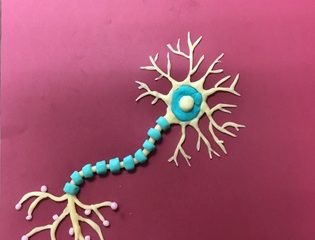
My daughter is an Assistant Professor at the University of Louisville and loves to share and help students and other professors learn social media. She’s presented all over the world and quoted by Forbes and USA Today among other prestigious media.
Here’s what we are talking about today:
“With a clever approach, researchers point to the first gene that could be protective of tinnitus — that disturbing ringing in the ear many of us hear, when no sound is present.
Ringing in the ears or hearing of a sound inside one’s head when no external sound is actually present is known as tinnitus. It’s a common problem that affects more than 1 person in every 10. While many learn to live with it, tinnitus can become much more than a minor ringing or buzzing sound. It can seriously disturb sleeping, concentration and daily living to the point of causing depression and anxiety.”
“Their research found that while brain size has increased by about 350% over human evolution, blood flow to the brain increased by an amazing 600%. The increase in the supply of blood to the brain appears to be closely linked to the evolution of human intelligence where the human brain has evolved to become not only larger, but more energetically costly and blood thirsty than previously believed.
Wits Brain Function Research Group co-author Dr Edward Snelling says: “Ancient fossil skulls from Africa reveal holes where the arteries supplying the brain passed through. The size of these holes show how blood flow increased from 3 million year old Australopithecus to modern humans.”:
“The study published Sept. 1 in Autism Research studied the variability of symptoms among kids with autism, not what causes autism. What they found is that exposure to diagnostic ultrasound in the first trimester is linked to increased autism symptom severity. The greatest link is among kids with certain genetic variations associated with autism; 7 percent of the children in the study had those variations.”
“This latest work – a joint collaborative effort lead by neuroscientist collaborators in Auckland, America and Germany – was published today in the high impact journal, The Journal of Neuroscience.
The study was funded by the Marsden Fund and the Neurological Foundation.
Lead investigator at the University of Auckland, Associate Professor Johanna Montgomery from the University’s Department of Physiology and Centre for Brain Research, says “This most recent work, builds significantly from our earlier work showing that gene changes in autism decrease brain cell communication.””
“In a study published online in Neuron, Harvard Stem Cell Institute (HSCI) researchers at Massachusetts General Hospital and the Broad Institute of Harvard and MIT in collaboration with an international team of scientists found they could bias the competition in favor of the newly generated neurons.
“The hippocampus allows us to form new memories of ‘what, when and where’ that help us navigate our lives,” said HSCI Principal Faculty member and the study’s corresponding author, Amar Sahay, PhD, “and neurogenesis–the generation of new neurons from stem cells–is critical for keeping similar memories separate.””
“Published today in Current Biology, the study funded by Alzheimer’s Research UK, Parkinson’s UK, Wellcome, MRC and the EU investigated the mechanism driving communication breakdown in adult brains – specifically, the loss of connections between nerve cells in the hippocampus, an area of the brain that controls learning and memory. The team found Wnt proteins play a key role in the maintenance of nerve connectivity in the adult brain and could become targets for new treatments that prevent and restore brain function in neurodegenerative diseases.”



8 Comments
mariecote · October 29, 2016 at 8:57 am
I read the article on autism and ultrasound. I found it interesting that the research question they were addressing was: why do kids with autism show different severity in symptoms. The outside stressor, ultrasound, was the center of this research and how it affects the first trimester, a critical period. Before reading this article, I believed ultrasound was a noninvasive tool, for both imaging and therapeutic purposes. As we learned in class, and in a developmental psychology class I’m taking, there are so many things that can go wrong during pregnancy due to exposure to potentially harmful stressors during critical periods. As mentioned in the article, ultrasound is not a cause of autism, but provides a potential correlation to autism. And though autism has a genetic basis, studies like these are important to inform mothers about potentially harmful environmental stressors.
RachelSemple · November 2, 2016 at 7:17 pm
I read the article titled “phantom noises”. This article stood out to me because, while I do not hear that high pitched ping inside my ear often, I actually experienced this just a minute before coming across this study. First of all, I did not realize that these “annoying high pitch sounds in my ear” had a specific term-tinnitus. What I find most personally confusing about this article is that a tinnitus is consistently defined as the high pitch sound in your ear when there is no other noise stimulus present. Personally, I experience this noise when there is other noises present. My most recent example is that just a few minutes ago I experienced this noise in my left ear while listening to my roommates watching the Cubs v Indians World Series Game. I may not have been completely focused on the game, but I could defiantly hear it, along with my roommates reactions. My house was far from quiet when I most recently experienced this noise. I pose the question if the noises I experience (very rarely)are tinnitus or separate category of “phantom noises”.
linnearamirez · November 7, 2016 at 12:26 pm
In the article “Autism severity linked to genetics, ultrasound, data analysis finds” suggests that autism severity is heightened by ultrasounds in the first trimester of pregnancy. The study states that further research must be done to determine if ultrasound exposure leads to the incidence of autism. I found this article relevant because I have worked with children with autism and have studied the increased incidence rate of the disorder. While I have read countless articles to try to hypothesize the cause of this disorder, scientists are still unsure of the causes. This article provides a potential stressor that influences the severity of autism but is preliminary and provides no raw data to support the hypothesis.
linnearamirez · November 7, 2016 at 12:36 pm
The article discussing memory loss discusses the findings of an experiment studying the impact of Dkk1, blocking the Wnts pathway effecting brain circuits and memory. When the Dkk1 was switched off in mice, they experienced fewer neural synapses and when the Dkk1 was switched on the mice no longer had memory problems. The articles findings support previous evidence suggesting that Wnts pathways are involved in memory and connectivity and when degraded, could have a role in Alzheimers disease. I recently went to Dr. Bennion’s lecture on sleep and memory. This article made me curious as to if the Wnts pathway is involved in heightened emotional memory following sleep versus following a wake period.
LaurenTaylor · November 25, 2016 at 12:53 pm
I found the article on Autism and ultrasounds very interesting. Until taking biopsychology, I had no idea of the negative effects of ultrasounds. Although, now it does make a lot of sense since you are exposing a developing fetus to radiation. This idea definitely makes me a little skeptical when considering future ultrasounds for myself. As stated in the article, an ultrasound done during the first trimester may increase the incidence of autism. I think it’s really important to educate future mothers on this in order to give them the proper preventative measures. Unless it’s necessary, ultrasounds should not be done until the second or third trimester.
RachelSemple · November 28, 2016 at 11:29 am
The article “Bloodthirsty Brains?” describes the correlation between size increase of the human brain and increased bloodflow to the brain. According to the article, the amount of bloodflow to the brain (and artery diameter) is closely linked to the size of the brain. This makes sense to me, because the human body is extremely complex and precise. The amount of flowlow that is necessary to support a smaller brain would not be sufficient to fully support a larger brain in the same was it does to the small one. I believe that bloodflow is an important tool that allows the brain to function properly; it makes logical sense that more brain requires more blood. As a result, I do not interpret this findings as surprising (although it is interesting), a follow up study that I am interested in is if the human brain has maintained the same flowflow to brain mass ratio throughout evolution. Does the brain now requires more bloodflow per square centimeter (or some other measurement) than it did thousands of year ago?
kmmenden · January 30, 2017 at 7:28 pm
I read the article about bloodthirsty brains. As we all know, brains have increased a lot in size since our early ancestors. What most people (including I) didn’t know is that blood flow to the brain has also increased, even more so than brain size has increased. In the article, they say that human brains have become more energetically costly – making them very bloodthirsty. It would be interesting to see what effects this may have on blood flow through the rest of the body or if there are any negative side effects from diverting so much blood to the brain.
kayleeroe · April 24, 2017 at 5:25 pm
I read the article, “Autism Severity Linked to Genetics, Ultrasound, Data Analysis Finds”. I enjoyed this article because it was very informative on a subject that I am passionate about. Knowing many individuals with autism spectrum disorder has increased by interest on the severity of the disease and how the symptoms vary between individuals. I believe this information about ultrasounds increasing the severity of symptoms for individuals with autism is crucial to know, because ultrasounds can be avoided during the first trimester of pregnancy, as long as health issues do not arise. This study has the potential to have a large impact on pregnant women and their children, as long as the word is spread.